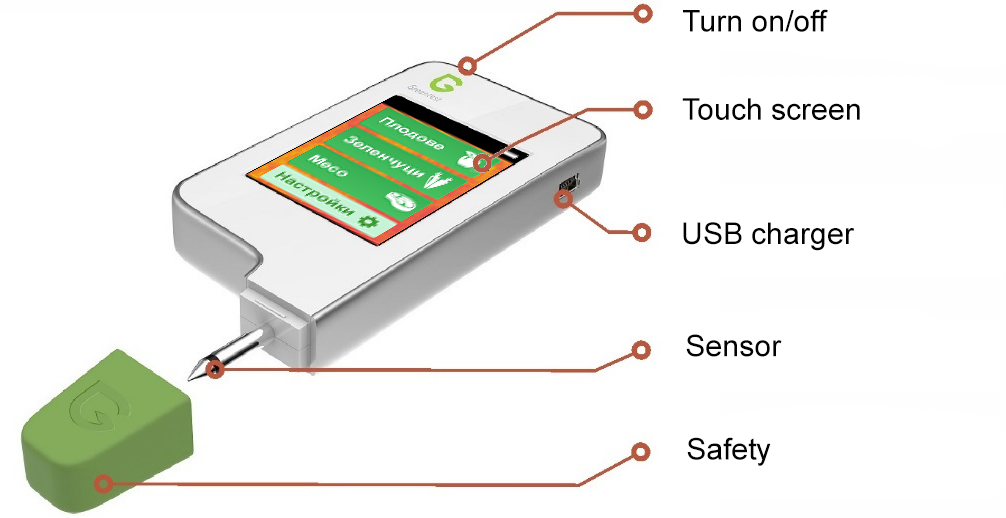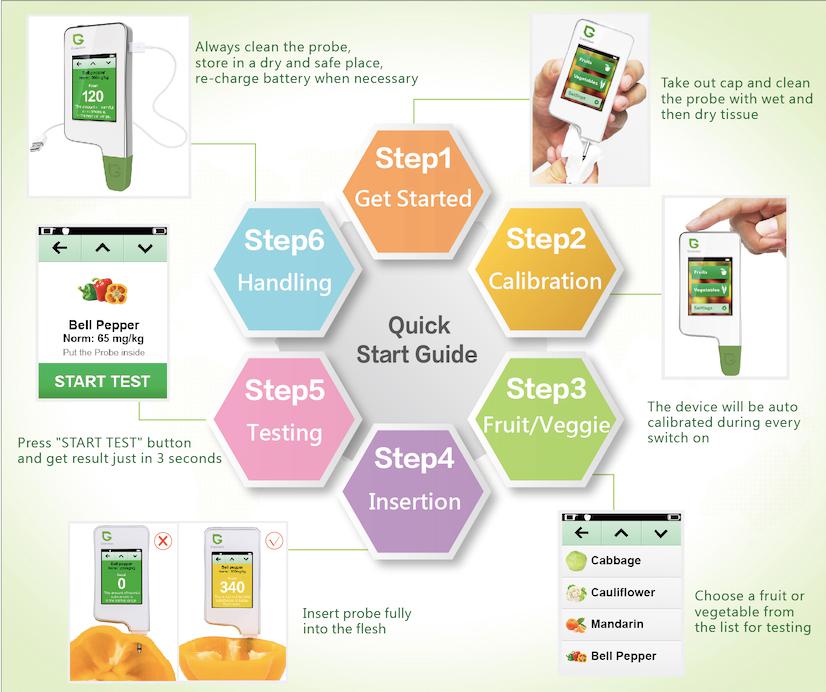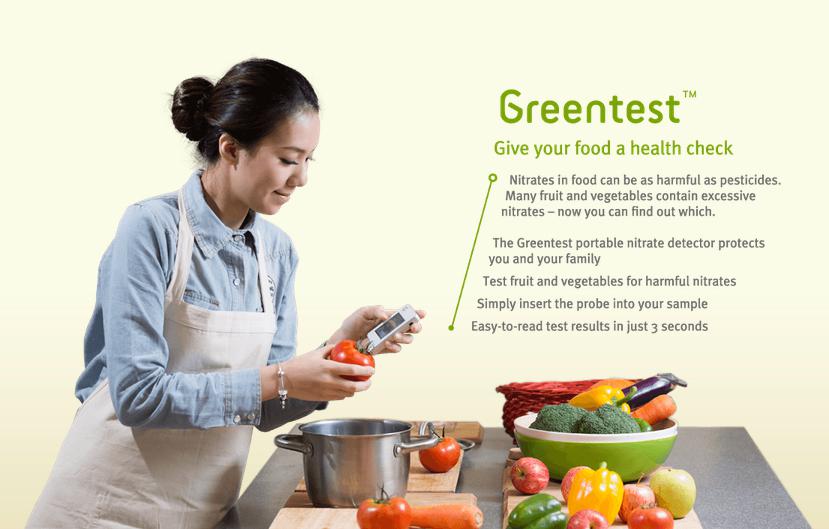
What does Greentest Eco detect? How can nitrates and radiation influence my health
and quality of life?
Greentest Eco is a device for quick test of nitrates in fresh fruit, vegetables and meat, as well as for background radioactivity levels test and detection of objects, food, building materials and other items contaminated with radioactive elements.
Of all the substances that are transferred to fruit and vegetables from fertilizers, nitrates are the most harmful if excess amounts are regularly consumed. Continuous intake of foods with high nitrate content may lead to an elevated risk of intestinal cancer, methemoglobinemia, diabetes, Alzheimer’s disease or nitrate poisoning.
Staying in a hazardous radiation zone or in the vicinity of objects with high background radiation leads to adverse effects of radiation exposure.
Note!
The highest radiation exposure is experienced by people in big cities, due to the natural background radiation being complemented by radioactive substances in building materials, air, food and radiation contaminated objects. Excess of natural background radiation leads to premature aging, weakening of eyesight, the immune system exhaustion, excessive anxiety, hypertension and congenital malformations in children.
What substances does Greentest Eco measure and how to use it?

Greentest Eco measures:
- Concentration of various salts in the tested product, including both salts that contain essential nutrients as well as salts that can cause serious harm to your health. Greentest Eco’s technology helps to detect the weight concentrations of salt ions such as: (Cl) chloride, (SO4) sulphate, (NO3) nitrate, and (NO2) nitrite-ions and calibrated to show the precise amount only of nitrate ions. Nitrate salts that accumulate in high concentrations due to improper cultivation of fruit and vegetables pose the most serious risk to human health. Based on the result, which is compared against international safe levels, Greentest will then recommend whether the fruit or vegetable you are going to consume is harmful to your health or not.
| Apple | 60 |
| Asparagus/Lettuce | 2000 |
| Asparagus | 30 |
| Banana | 200 |
| Beetroot | 1400 |
| Bell pepper | 250 |
| Bitter gourd | 400 |
| Broccoli | 2000 |
| Cabbage | 900 |
| Carrot | 400 |
| Cauliflower | 2000 |
| Celery | 2000 |
| Citrus | 30 |
| Cherry | |
| Cherry Radish | 1500 |
| Chinese Cabbage | 2000 |
| Choy Sum | 2000 |
| Corn | 30 |
| Cucumber | 400 |
| Eggplant | 300 |
| Gai-lan | 2000 |
| Garlic | 70 |
| Ginger | 1300 |
| Grape | 60 |
| Green Lettuce | 2000 |
| Jack Fruit | 30 |
| Kiwi | 60 |
| Lichee | |
| Longan | 30 |
| Luffa | 60 |
| Mango | 30 |
| Mangosteen | 30 |
| Marrow | 400 |
| Melon | 90 |
| Mushroom | 40 |
| Nectarine | 60 |
| Onion | 80 |
| Pak Choi | 2000 |
| Peach | 60 |
| Pear | 60 |
| Persimmon | 60 |
| Pineapple | 30 |
| Pitaya | 30 |
| Plum | 30 |
| Potato | 250 |
| Pumpkin | 400 |
| Purple Potato | 250 |
| Scallion | 600 |
| Shanghai Vegetable | 2000 |
| Star Fruit | 30 |
| Strawberry | 100 |
| Sweet Potato | 250 |
| Taro | 250 |
| Tomato | 300 |
| Turnip | 1000 |
| Watermelon | 60 |
| Winter melon | 400 |
| Yam Rhizome | 850 |
| Meat | 200 |
- Background radiation determined by the amount of power of ionizing radiation (gamma-ray and beta-particle flux). Having compared the measurements with the international standards, Greentest Eco displays the test results
How can I protect myself from excess amounts of nitrates found in fruit and vegetables?

With the help of Greentest Eco you can immediately check the exact concentration of nitrates in your fruit and vegetables and decide whether it is safe to consume them or not.
The World Health Organization’s (WHO) suggested 3.7mg. of nitrates per kg. of body weight as a maximum daily intake for adults. For example, if your body weight was 50 kg., then your suggested maximum daily nitrate intake would be 185mg (50 kg. x 3.7mg). So, if you used the Greentest device to test a common vegetable like cabbage and obtained a test result of 1100 mg./kg. of nitrates, then an adult could only safely eat 185 (mg)/1100 (mg/kg) = 0.168kg or 168 g. of this cabbage.
As a rule, people consume several kinds of fruit and vegetables per day and would like to make sure the total nitrate intake is far below the daily limit by carefully checking all food. Food with preservatives may also contain significant amount of nitrates, which should be considered when calculating the daily nitrate intake.
Also, note that suggested daily nitrate limits for children are much lower than for adults. Children are more susceptible to the harmful effects of nitrates, hence the suggested daily nitrate limit for children younger than one year old is 30 mg. For older children the suggested daily nitrate intake limit is 50 mg.
Here are some practical suggestions about how you can minimize levels of nitrates in your diet:
- eat mostly seasonal fruit and vegetables as they require less fertilizers, pesticides and chemicals during cultivation;
- wash greens, fruit and vegetables thoroughly before eating;
- discard of all the spoiled areas; cut peeled vegetables in half and soak in cold, slightly salted water for 30-40 min (this procedure substantially lowers the level of nitrates in products you tested);
- boil vegetables in a large pot of water and discard the water;
- don’t use in aluminum dishes for salads; peel off the skin and discard those parts where high levels of nitrates were detected.
On the other hand, intensive treatment such as soaking and boiling for long periods of time leads to losses of the nutritious bioactive substances including vitamins, macro – and microelements, polyphenols, etc. found in fruit and vegetables.
Note!
When testing fruit, vegetables or meat with your Greentest Eco device you may notice wide variations in the concentration of nitrates (twofold or more) within different parts of the same fruit or vegetable. This is normal as there may be an irregular distribution of nitrates within the fruit or vegetable. For example, higher concentrations of nitrates are often found closer to the stalk or seeds of a tomato or cucumber. If that part is localized and its weight is small, then the amount of nitrates it contains will not pose much of a health risk. However, if the Greentest device detects an amount of nitrates above the limit (display shows red), we advise you to cut that part of the plant out and discard it.
How can I protect myself from the influence of background radiation and radiation in objects?
In case of detecting a high level of the background radiation by Greentest Eco it is advisable to leave the hazardous area immediately and report the findings to the authorities. If the source of the high level of radiation is an object, the course of actions should be as above.
Sertificates
 |
Best Testing & Analysis Corp. | Declared accuracy√ |
| Nitrate level detection | Above 90%√ | |
 |
Shenzhen Academy of Metrology & Quality Inspection | Declared accuracy√ |
| Nitrate level detection | Above 90%√ | |
 |
Société Générale de Surveillance (SGS) | Declared accuracy√ |
| Nitrate level detection | Above 90%√ |
 |
WEEE | Certified√ |
| Waste Electrical and Electronic Equipment Directive | Certified√ | |
 |
Conformité Européenne | Certified√ |
| LVD | Certified√ | |
 |
Conformité Européenne | Certified√ |
| EMC | Certified√ | |
 |
China Quality Certification | Certified√ |